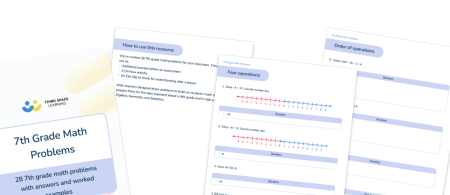28 7th Grade Math Problems With Answers And Worked Examples
7th grade math problems build on students’ reasoning skills and understanding of key mathematical concepts.
We’ve created 28 7th grade math problems for your classroom, suitable for use as additional practice before an assessment, as a Do Now activity, or for an Exit Slip to check for understanding after a lesson. Math teachers designed these problems to build on students’ math skills and help to prepare them for the rigor expected ahead in 8th grade and in high school courses like Algebra, Geometry, and Statistics.
What are 7th grade math problems?
7th grade math problems combine 7th grade math concepts with grade-level appropriate reasoning and problem solving skills.
7th grade math content includes computing with all rational numbers in all four operations, using the correct order of operations to simplify expressions, solving problems involving percentages, using proportional reasoning, solving 1 and 2 step equations, multi-step inequalities and extending knowledge of geometry.
Why focus on problem solving in 7th grade?
Excelling at computation is great; excelling at computation but not understanding application is pointless. The purpose of mathematics is to learn to reason, find patterns, and use logic, so solving math problems that are rich, deep, and complex is necessary to meet those purposes.
Mathematics today has advanced beyond just computation and evolved into a marriage of numbers and words – not only do students need to get to a numerical answer they also need to be able to communicate their thinking and processes along the way. They need repeated practice in reasoning, perseverance, and rational thinking to solve problems throughout their lives.
7th grade is a perfect time to extend problem solving activities in the classroom. The curriculum moves away from much of the memorization required in elementary school of basic addition facts and times tables, and builds on 6th grade content to focus on making connections between mathematical reasoning, logic, and numbers.
28 7th Grade Math Problems
28 7th grade math questions targeting the skills and knowledge needed for the four operations, order of operations, percentages, proportional relationships, one-step and two-step equations, geometry and word problems. Includes answers and explanations.
Download Free Now!The 7th grade math curriculum
This article focuses on problems for 7th grade students, especially concepts taught in pre-algebra. Pre-algebra includes concepts of proportional relationships, algebraic expressions, equivalent expressions, equations, rational numbers, graphs, and extension of knowledge of the number system, including whole numbers and mixed numbers. The problems align with common core standards.
Seventh grade math can be considered a turning point in mathematics. It bridges the concepts taught in elementary school, including the foundations of arithmetic and number sense, with the rigor expected ahead in high school courses like Algebra, Geometry, and Statistics.

Meet Skye, the voice-based AI tutor making math success possible for every student.
Built by teachers and math experts, Skye uses the same pedagogy, curriculum and lesson structure as our traditional tutoring.
But, with more flexibility and a low cost, schools can scale online math tutoring to support every student who needs it.
Find out more7th grade math problems
We’ve designed 28 7th grade math problems to use as a whole class or in a Tier 2 or Tier 3 intervention to help develop and secure students’ mathematical knowledge.
7th grade math problems: Four operations
- Solve -4 + 10. Use the number line.

Solution: 6
2. Solve: -8 – 12. Use the number line.

Solution: -20
3. Solve: 4(-3)(-2)
Solution: 24
4. Bill said the answer to -3 – 12 is 9. What mistake did he make? What is the correct answer?

Solution: Bill knows that the opposite of subtraction is addition, but he forgot to take the opposite of 12, so he re-wrote the problem as -3 + 12. Since we are subtracting 12 from -3, the answer is the same as -3+-12, which is -15.
7th grade math problems: Order of operations
5. Solve: 2(10-8) ÷ 2 + 4
Solution: 2(10-8) ÷ 2 + 4
2(2) ÷ 2 + 4
4 ÷ 2 + 4
2 + 4
6
6. Solve: (3 + 10 ÷ 2 – 6) x 6
Solution: (3 + 10 ÷ 2 – 6) x 6
(3 + 5 – 6) x 6
(8 – 6) x 6
2 x 6
12
7. Solve: -5(8) ÷ 2 + 6
Solution: -5(8) ÷ 2 + 6
-40 ÷ 2 + 6
-20 + 6
-14
8. Solve: (-2)3 – 2 + 6 ÷ 3
Solution: (-2)3 – 2 + 6 ÷ 3
-8 – 2 + 6 ÷ 3
-8 – 2 + 2
-10 + 2
-8
7th grade math problems: Percentages
9. Isabella got 16 out of 40 questions wrong on her quiz. What percent did she get correct?
Solution: \frac{16}{40} can be simplified to \frac{2}{5}, which is equivalent to \frac{40}{100} or 40%. If Isabella got 40% incorrect, she got 60% correct (100-40=60).
10. Without doing any computation, explain whether \frac{38}{72} is greater than or less than 50%.
Solution: \frac{38}{72} is greater than 50%. \frac{36}{72} is equivalent to \frac{1}{2}, which is equivalent to 50%. Since 38 is a little greater than 36, \frac{38}{72} is a little greater than 50%.
11. Put the following in order from least to greatest: \frac{3}{4}, 76%, 0.68, \frac{3}{5}, \frac{35}{50}, 0.702
Solution: \frac{3}{5}, 0.68, \frac{35}{50}, 0.702, \frac{3}{4}, 76%
12. A store marked all shoes on sale for 30% off. What percent will Sam pay for shoes? Explain your answer.
Solution: Sam will pay 70% for shoes. The full price is 100%, so if 30% is saved, the remaining 70% will be the sales price.
7th grade math problems: Proportional relationships
13. \frac{5}{6} = \frac{x+2}{15}
Solution: 6(x+2) = 5(15)
6x + 12 = 75
-12 -12
\frac{6x}{6}= \frac{63}{6}
x = 10.5
14. Three out of every five students are wearing jeans. If there are 20 students in total, how many are wearing jeans?
Solution: \frac{3}{5} = \frac{x}{20}
3 (20) = 5x
60 = 5x
12 = x
15. Three out of every five students are wearing jeans. If there are 20 students in all, how many are not wearing jeans?
Solution: From the last problem, we saw that \frac{3}{5} is the same as the 12 students wearing jeans. If there are 20 students total, we can subtract the 12 wearing jeans from the 20 total to find that 8 are not wearing jeans. We could also set up this proportion and solve to get 8.
\frac{2}{5} =\frac{x}{20}
16. A museum requires 12 chaperones for the 60 students attending the field trip. How many students are assigned to each chaperone?
Solution:
\frac{12}{60} = \frac{1}{x}
12x = 60(1)
12x = 60
x = 5
Each chaperone will have a group of 5 students.
7th grade math problems: One-step equations and two-step equations
17. Solve: x + 7.1 = 15.9
Solution: x + 7.1 = 15.9
-7.1 -7.1
x = 8.8
18. Solve: x – 63 = 106.75
Solution: x – 63 = 106.75
+63 +63
x = 169.75
19. Solve: 6(x + 3) = -6
Solution: 6x + 18 = -6
– 18 -18
\frac{6x}{6} = \frac{-24}{6}
x = -4
20. Solve: 0.5x + 10 = 36
Solution: 0.5x + 10 = 36
-10 -10
0.5x = 26
x = 52
7th grade math problems: Geometry
21. Madison measured this angle with her protractor and said “It is 60°.”
Without measuring the angle, Bella said she could tell Madison’s answer was incorrect. How did Bella know this?

Solution: Bella knew this angle could not be 60° because this angle is obtuse
but a 60° angle is acute.
22. Find the circumference of the circle.
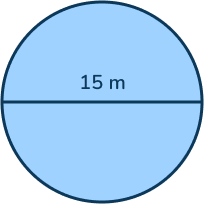
Solution: C = πd
C = 15π
23. Use the figure to fill in the blanks:
Angles A and B are _________________ angles so their measures are _______________________________.

Solution: Angles A and B are vertical angles so their measures are equal.
24. Find the value of x.
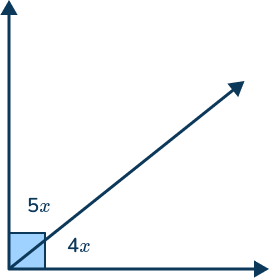
Solution: 5x + 4x =90
9x = 90
x = 10
7th grade math problems: Math word problems
25. The 7th Graders at Marxville Middle School voted for their student council representatives. There were 200 votes cast in all. How many votes did the winner get?

Solution: Alexandra won the election with 30% of the votes. To find 30% of the 200 total votes, we can multiply 0.3 (200) to discover that she got 60 votes in all.
26. Brian runs every 12 days and Stella every 8 days. Both Brian and Stella ran today. How many days will it be before they both run on the same day again?
Solution: This is a Least Common Multiple problem. Brian runs on days 12, 24, 36, 48… and Stella runs on days 8, 16, 24, 32…, so they will both run again on Day 24.
27. Mr. Orlando is planting his vegetable garden this summer. He plants \frac{3}{4} of the garden with peppers and \frac{1}{4} with tomatoes. Of the peppers, \frac{1}{3} are red peppers. What fraction of the entire garden will be red peppers?
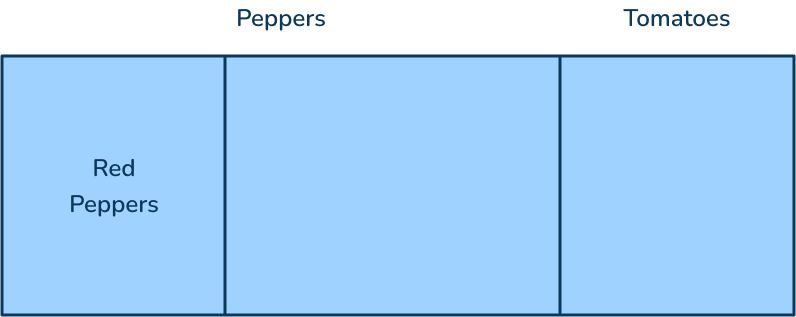
Solution: Red peppers will make up \frac{1}{3} of \frac{3}{4} (the pepper section) of the garden. \frac{1}{3} x \frac{3}{4} = \frac{1}{4}, so \frac{1}{4} of the entire garden will consist of red peppers.
28. Will the product of -45(96) be positive or negative? Without solving, how do you know?
Solution: The answer will be negative. Multiplying a negative number by a positive one always leads to a negative product.
Challenges in teaching 7th grade mathematics
Let’s face it, most 7th graders don’t wake up every morning excited to get to math class that day to expand on their mathematical knowledge and thinking! Often, there are much more pressing matters in the mind of a 12 year old. However, with the right mindset and classroom climate, we can support our students to help them put forth their best effort every day.
- Praise effort: Developing a growth mindset in the classroom is key. Even if a student struggles to come to an answer, it is critical to praise the effort. We must make the thinking part of mathematics something to treasure rather than solely focus on correct numerical answers.
- Include low threshold high ceiling activities: These go a long way in piquing the interest level of most students.
- Have fun: Don’t be afraid to have some fun math activities and silliness in your lessons, whether that’s through funny estimation activities or videos to get students interested, engaged and willing to try.
How can Third Space Learning help with 7th grade math?
Skye, Third Space’s Learning conversational AI math tutor built by teachers and math experts, helps every struggling 7th grade math student who needs it, close learning gaps and address misconceptions.
During the one-on-one AI math tutoring sessions, Skye helps students deepen their understanding of the math curriculum and keep up with difficult math concepts, talking through explanations, encouraging learners to verbalize their reasoning as they go, and using tools like modeling, scaffolding, and real-life contexts to help learners understand and solve problems, excel, and have fun.
Skye has been specifically trained to teach math to address learning gaps, boost math knowledge and progress, build problem-solving skills, deepen understanding, and boost confidence.
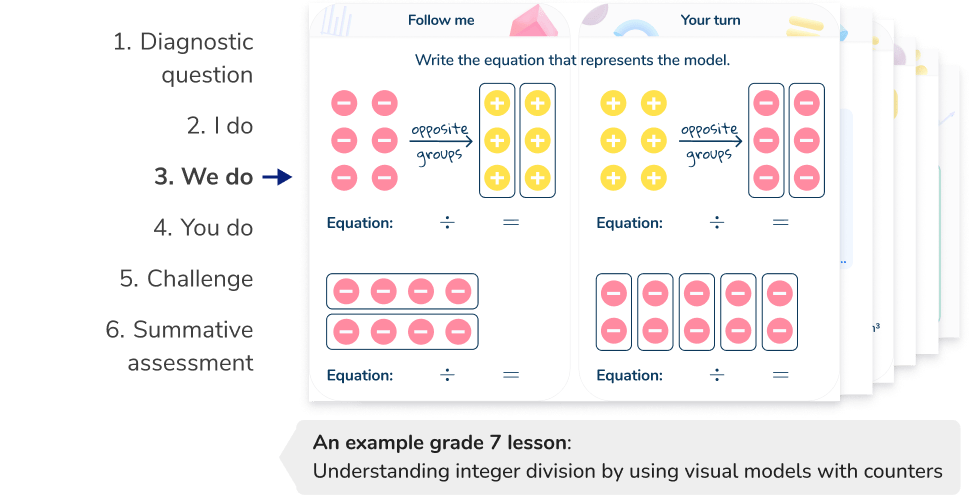
4 top tips for teaching 7th grade math problems
Here are some teaching tips to overcome common challenges and support problem solving in your classroom:
- Focus on effort, not accuracy: Students come into 7th grade with many ideas about math. Many of these ideas are likely negative and may result in some math anxiety. They’ve heard math is hard, you’re never going to use it, it’s confusing.
Be excited about what you’re teaching and learning! Praise kids for trying their best, not for always being correct. Consider establishing effort-based reward systems, such as publicly nominating students for Mathematician of the Month. - Check for understanding: Be sure students understand questions before they attempt to answer them. Have them rephrase the question or explain what they’re looking for to solve the problem.
- Ask for wrong answers: Students may feel a lack of confidence in math but if you ask them for a wrong answer, they may feel more inclined to answer. It can also prompt students to engage with and make sense of the information given in the problem in a less pressured environment.
Alternatively, as teachers, you can give some suggestions. For example, “3/10 of students got an A on the last test. There are 20 students in the class. How many got an A?” Could 20 of the students have gotten an A? No? Why not? Could 8.5 of the students have gotten an A? Why not? Then get more specific. Did more or less than 10 of the students get an A? How do you know?
- Use relatable, real-world problems: Sometimes, problem solving uses questions about gas mileage or building fences that kids either don’t relate to or don’t care about. Find out what your students’ interests are and incorporate that into your math instruction. Alternatively, use seasonal and relatable contexts such as Thanksgiving math activities, summer math or mardi gras math.
7th grade math worksheets
Looking for more resources? Please see our selection of seventh grade math worksheets covering 7th grade key math topics and more. Each includes printable resources and step-by-step answer keys:
- Surface Area Of Rectangular Prisms Worksheet
- Fraction to Decimal Worksheet
- Adding and Subtracting Integers Worksheet
- Adding and Subtracting Scientific Notation Worksheet
- Distributing Exponents Worksheet
- Simplifying Expressions Worksheet
7th grade math problems FAQ
What math should a 7th grader know?
A 7th grader should be able to compute using all four operations with positive and negative rational numbers. They should be able to simplify expressions, solve one- and two- step equations, and solve proportions. Additionally, 7th graders can work with probability of simple and compound events, as well as study concepts of geometry, including finding angle measurements and solving for area and perimeter of regular and irregular polygons and circles.
What does 7th grade math focus on?
Seventh grade math focuses on working with positive and negative rational numbers in simplifying expressions and equations as well as solving one- and two-step equations. Additionally, extensive work is done in solving proportions and ratios.
Is 7th grade math hard?
Seventh grade math is always achievable! Students who find it hard usually come into the grade without having mastered basic concepts and facts. Be sure students are automatic with facts across addition, subtraction, multiplication, and division and have the ability to work with fractions and decimals. It will make the new concepts in 7th grade easier to learn.



